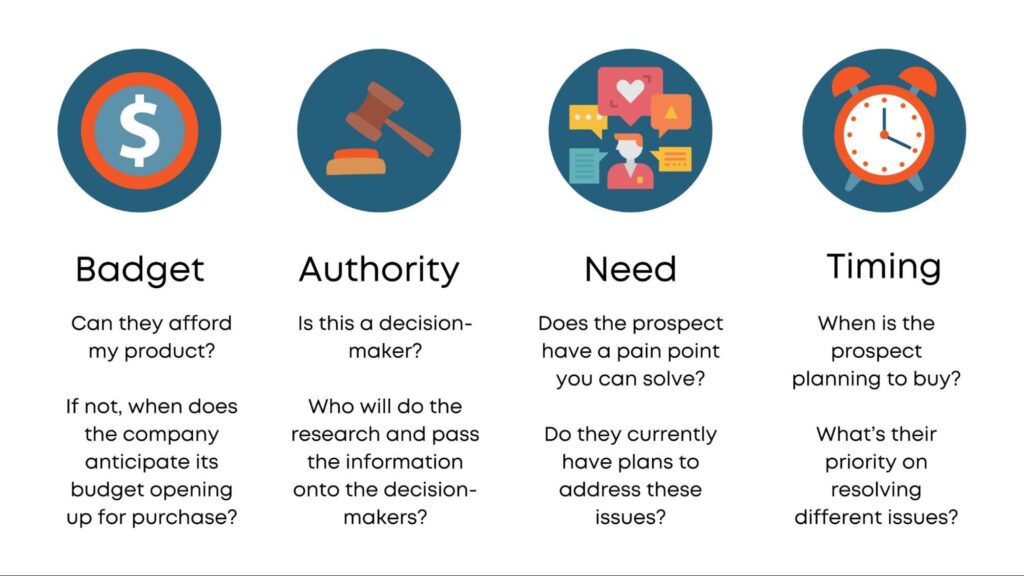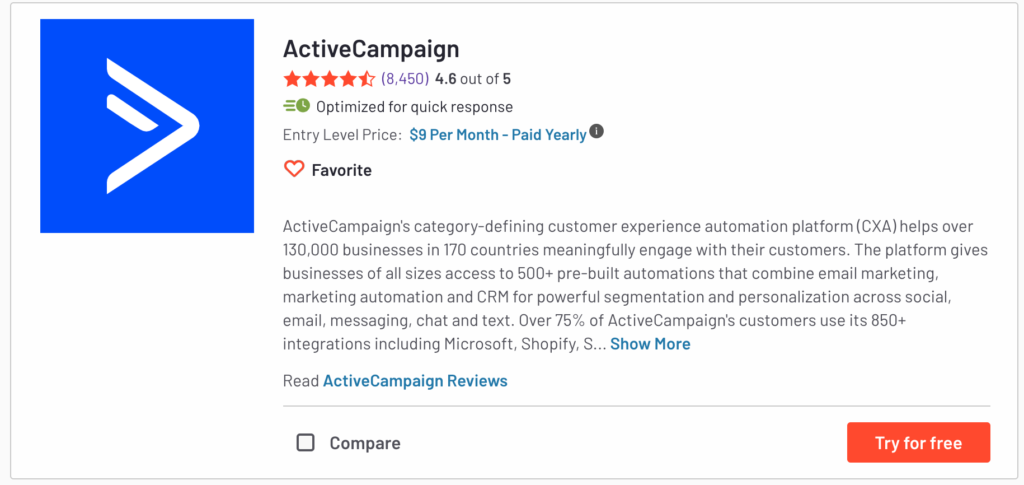- What is lead qualification?
- Who is a qualified lead?
- An information qualified lead (IQL)
- A marketing qualified lead (MQL)
- A sales qualified lead (SQL)
- A product qualified lead (PQL)
- Unqualified leads
- Lead disqualification
- 5 steps to qualify leads
- Create a good lead capture form
- Organize leads database
- Outreach
- Choose a lead qualification tools and frameworks
- Implement a lead scoring system
- 4 best lead qualification tools
- ActiveCampaign
- 6sense ABM/ABX platform
- VanillaSoft
- Infer
- Summing Up
- Author Bio
Best Solutions for Lead Qualification
November 1, 2021 10 min. read

Contents:
Try AI-Driven Insights
Monitoring for Free
Discover new business ideas and growth opportunities using
our AI-powered insights monitoring tool
According to the latest Hubspot report, lead generation is a top priority for marketers around the world in 2024. However, the results of their campaigns are far from what’s expected. Businesses continue to struggle with finding people who are interested in their products or services. It’s easy to buy a list with users’ data, but here’s the rub – how many of those leads can you turn into customers?
Lead qualification helps to prioritize your leads based on their types. There are lots of ways to achieve it – from frameworks to lead qualification tools. This article will show the best ones.
What is lead qualification?
Leads are people who may be your clients one day. Some of them have a high chance of buying from your company (they are called prospects). And some don’t fit your ideal customer profile at all.
Lead qualification allows you to determine who is more likely to become a purchaser based on the data you have. Focusing on the right audience is crucial because time and budget are limited. When trying to reach out to leads in different stages of their journey with one-size-fits-all nurturing campaigns, you’ll end up with no prospects in your pipeline.
Who is a qualified lead?
A qualified lead is a person who is aware of the benefits your product can bring. And, based on the criteria you have set, they have all chances to become your customer. There are at least four types of qualified leads:
An information qualified lead (IQL)
IQL (also known as a cold lead) is somebody in the first stage of the buyer’s journey. It can be a LinkedIn user you have found via search or someone who has left a question on Quora and needs help. They don’t know your brand yet, but they started researching a potential problem they face. This type of lead requires educational content. By providing it, you can receive their contact data in exchange and run a series of follow-ups.

A marketing qualified lead (MQL)
MQL (a warm lead) is a person who has indicated some interest in what you have to offer. For example, they have used software demos or submitted an email address for a newsletter and continue to engage with it. A marketing team determines this type based on criteria such as:
• web pages a lead have visited;
• content offers they downloaded;
• CTAs they clicked;
• and social posts they have interacted with.
A sales qualified lead (SQL)
MQLs who have passed through the sales team are SQLs. They are also known as hot leads.
They have received enough nurturing and personalized follow-up and are ready to buy.

A product qualified lead (PQL)
A PQL is relatively a new term. We use it to define a user who has successfully tried our SaaS product by a free trial or a freemium model. They have tested some of its features and completed specific tasks. A sales rep doesn’t have to sell the user the product again. Their job is to convince PQL to take a paid plan.
Unqualified leads
An unqualified lead is a contact that is not ready to buy from you. There are some reasons why it happens:
1. Your lead nurturing is not effective.
2. Your product or service is expensive for them, or they don’t have the authority to make purchasing decisions.
3. People aren’t sure what your company offers.
4. Maybe, they need a specific solution and don’t know it.
5. Your offer isn’t relevant to them.
In some cases, your marketing team needs to start a lead nurturing campaign to re-engage them. Make sure you communicate with a person on an individual level through all customer journey stages. Send them educational and targeted content that would explain why your solutions are valuable.
But most often, it’s best to let unqualified leads go. If you don’t have unlimited resources, trying to convert people who have no interest in what you offer is a dead end.
Segmenting leads into these five types helps you to define your tactic for dealing with each of them. Thus you will receive an opportunity to create different content that would be more effective than a generic one. If you push the wrong type of leads directly to sales when they aren’t ready, you will lose them.
Lead disqualification
A disqualified lead is a contact who was eliminated from your list because you can’t reach out to them, or they have no interest / no budget for your services.
It’s essential to analyze the reasons behind disqualifying contacts. It might help you to reveal a problem in your lead generation strategy and then fix it.
5 steps to qualify leads
Before the qualification process starts, you need to create your buyer persona. When you understand what you are looking for in buyers, it becomes easier to qualify leads that meet your profile and disqualify those that don’t.
Create a good lead capture form
A lead-capture form is a vital focus of a landing page. The form should include questions that will lead to the answers you need most for lead qualification. Make sure you ask for the most crucial information first – name, email, phone number. To get better results, design multi-step forms and involve chatbots in the process.
Organize leads database
Choose customer relationship management (CRM) software that suits your company. CRM is a centralized platform that keeps all history of interactions with your brand and assists you in managing leads’ accounts. It shows which kind of communication your contacts are engaging with. Moreover, you can add a detailed note about someone’s profile and share it with the sales team.
There are also plenty of other features of CRM. You choose a system based on the size of your company, industry, budget, and specificity of workflow.
Though CRM is highly automated, you have to enter some data manually and check if the information is updated. Do not forget to get rid of dead leads – contacts that ignore your emails and don’t need your services anymore. Instead, optimize your daily schedule and prioritize tasks to ensure no lead is overlooked or forgotten.
Outreach
Sometimes you need more information than you can find on social media or receive from capture forms. People can fill it in a hurry, or they don’t think that some questions are that important, especially if the answer isn’t brief. There are also situations when you realize that some points are key in your lead scoring model after running it. For instance:
• What problem do you want to solve?
• Do you have any solutions to it? If yes, are you experiencing pain points? What are they?
• What is your ideal timeline for achieving this?
• What is your company’s budget for this solution?
The right qualifying question helps you to build up a track record of lead’s experience. If you learn that contacts have already talked to your competitors, you can come in with your differentiating factors. And if your prospect has no solutions at all, you have more space for yours.
Choose a lead qualification tools and frameworks
The next big thing in lead qualification is frameworks. They are ready-made solutions for a sales team to decide if a lead is worth spending resources on. A lead qualification framework provides a standardized process through which anyone from the sales department can easily qualify or disqualify leads.
There are many qualification frameworks – from the oldest BANT from the ‘60s to the newest NOTE introduced by Sean Burke in 2016. It would be best to learn them all to pick the one that fits your team’s customer profile and selling styles. If you haven’t found the proper ones, you can create your own.
BANT
BANT stands for Budget, Authority, Need, Timeline. It was developed by IBM to provide sales reps with a simple algorithm of questions.

The system marks a lead that meets at least three of the four BANT as valuable. Though, each sales team can decide what a viable lead looks like to them.
There are many critics of the framework. For example, Jim Keenan, the founder, and CEO of A Sales Guy Inc, thinks that BANT is “incredibly seller-focused” and doesn’t care enough about the prospective buyer. He points out that the business is all about prospects, and anything else doesn’t matter that much.
Nevertheless, BANT is still popular, and some companies adjust it to their needs.
GPCTBA/C&I
Today, new frameworks occur because the power shift has gone to the buyer’s side rather than the salespeople. GPCTBA/C&I, developed by Hubspot, is one of them. GPCTBA/C&I is an acronym that stands for Goals, Plans, Challenges, Timeline, Budget, Authority, [Negative] Consequences, and [Positive] Implications.
The framework aims to qualify whether a prospect truly could benefit from your products and services. It consists of three parts:
• GPCT(Goal, Plan, Challenges, Timeline)
• BA (Budget and Authority)
• C&I (Negative Consequences and Positive Implications)

GPCTBA/C&I may be the correct choice for B2B. It extracts every possible detail and checks every box required. Yet, it may be excessive for small solution sales.
MEDDIC
Dick Dunkel created MEDDIC at Parametric Technology Corporation (PTC) in 1996. As a result, PTC achieved over $10bn of revenue, according to the company’s data.
MEDDIC works better for B2B. It’s more detailed than other frameworks and focuses on the long-term and risk-mitigation parts of a deal. Its acronym stands for:
• Metrics
All goals your lead wants to achieve should be quantifiable. It would be great to ask them how they would measure success.
• Economic Buyer
The Economic Buyer is a person of a group of people that makes a financial decision. You may not engage with them, but it’s crucial to analyze their mindset and priorities.
• Decision Criteria
What factors are essential for your leads’ company when they compare many different vendor choices to make a decision? The possible answers to this question are potential ROI, affordability, set-up time, etc.
• Decision Process
What is the series of steps in the decision-making? Try to find out the names and positions of people your contact needs to persuade to finalize the process. What paperwork would they need?
• Identify Pain
Ask the lead the specific pain points they are experiencing, and then show how you can solve these problems.
• Champion
Find a champion – someone inside the company who pushes for you and has influence. Think about who can benefit the most from your solution and contact them? This person helps to maintain the interest in your offer.
Implement a lead scoring system
Marketing and sales teams that have to process hundreds or thousands of leads per month require a strategy to find the best potential customers. Lead scoring is a perfect solution.
It’s a process of ranking your contacts against a scale in numerical values based on their actions. You assign each user their score (often 1-100). It allows you to go after the high-value prospects.
Though a lead score includes a lot of data points, it effectively consists of three essential components:
• Online behavior (amount of time they spend interacting with your website, the frequency of visits to the website, click-through rates for emails sent to them)
• Demographics attributes (age, location, job title, and salary)
• Firmographics (job title, industry, company revenue, purchase history)
The good news is that today everyone can set up a customized lead scoring model. Marketing tools have become more sophisticated. They are capable of even automating your lead scoring workflow with them.

4 best lead qualification tools
If your marketing and sales team is overloaded by manual lead scoring, consider using automation software. It adjusts a score based on any rule you set and allows you to focus on prospects that are close to becoming buyers.
And if you already have a CRM, it might not be enough to qualify leads alone. There are lots of cases when companies need to invest in artificial intelligence, and it’s easier to do with additional software. Below are the top-four lead qualification tools to choose from, according to G2.
ActiveCampaign

Source: g2.com
ActiveCampaign is a customer experience automation platform for eCommerce, B2B, and B2C companies. It’s cloud-based and includes a CRM built for small-medium-sized businesses. So, there are options besides lead scoring.
With ActiveCampaign, you can score contacts and deals. The platform activates as many programs at the same time as you want. It also sets scoring systems for different categories. For example, you could have separate scores for characteristics and engagement and special scores for email interaction.
There is no set-up cost. The pricing starts at $9 monthly for accounts with less than 500 contacts. The more lead you have, the higher price is. If you want to test the service but aren’t sure it will meet your needs, the company offers a 14-day free trial.
6sense ABM/ABX platform

Source: g2.com
6sense is an account-based platform that helps B2B organizations achieve predictable revenue growth. It puts together the power of AI, big data, CRM, and machine learning to create personalized engagement for every stage of the customer journey.
The company introduced 6QA (6sense Qualified Accounts) that uses AI to score leads. AI-powered predictions determine the lead’s position in the buyer’s journey and calculate the ideal time for engagement.
Furthermore, 6sense segments your audience and shows the history of interactions for a particular group, so you see what happened with them during a set period of time.
However, if you want to look at 6sense capabilities yourself, there is no free trial or freemium version. To buy a service, you’ll have to negotiate the price with the company.
VanillaSoft

Source: g2.com
VanillaSoft is a sales engagement platform that assists businesses in managing leads. It defines their priority as they progress through the sales funnel and creates custom reports to analyze campaigns.
This platform aims to track constant movement through the entire sales cycle and ensure every sales rep follows up with the closest person to the purchase.
The company offers customized solutions to lead qualification. You can adjust it once your company changes the lead scoring model or an ideal customer profile.
The base platform will cost $80 per user per month. If you want to add additional features, you’ll have to pay for each separately.
Infer

Source: g2.com
Infer is a lead scoring platform with AI, CRM, and marketing automation integrations. The company uses machine learning algorithms to find patterns in your data and predict which prospects are most likely to buy your product.
The company established behavioral models to mine prospects’ activity data inside your marketing automation platform. It combines this information into a roadmap that shows users who are closer to buying.
With Salesforce integration, Infer reports which business size and industry segments are surging, so you can see if your campaigns are reaching target markets.
If you want to see how the application works, you can request a demo version. The company hasn’t provided pricing information yet.
Summing Up
Armed with CRM, lead qualification tools, and frameworks, you’ve got all the information to find high-value prospects. With automation of lead capturing and scoring processes, you’ll eliminate human errors and spare time for more valuable tasks.
Author Bio

Kristina Shkriabina is a content marketing manager at Koroka Solutions, Odessa, Ukraine. She has a background in broadcasting journalism and British parliamentary debate.
More useful content on our social media:
